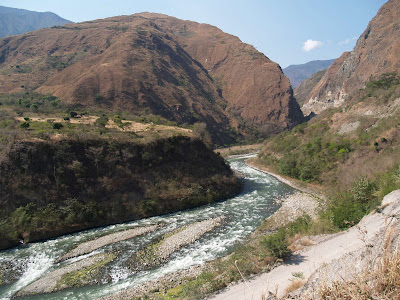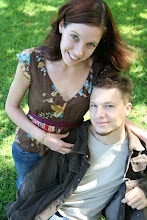Cusco
From Nazca we took another overnight bus to Cusco. Certainly for me (Tim), this was the worst I have ever taken. (And I think they acknowledge this fact since everyone is fingerprinted and videorecorded before getting onboard so they can identify people incase the bus doent make its intended destination!)
Like the plane ride, this too is guaranteed to be a vomit inducing ride. (Almost the whole 14 hours for myself and many other passengers). The road was incredibly tortuous (if it had any straight sections, I didnt notice them!) and combined with the rapid change in altitude it was not an enjoyable experience for most people! However, this time the destination was definitely worth the pain to get there.

Like the plane ride, this too is guaranteed to be a vomit inducing ride. (Almost the whole 14 hours for myself and many other passengers). The road was incredibly tortuous (if it had any straight sections, I didnt notice them!) and combined with the rapid change in altitude it was not an enjoyable experience for most people! However, this time the destination was definitely worth the pain to get there.


We arrived mid-morning in Cusco. The centre of the ancient Incan empire.
Unfortunately the spanish concourers didnt like the fact that they werent Christian and set about showing them the right way by destroying their temples, building churches on these sacred sites and remodeling their pagan city.
My question is... who in their right mind decided that it would be a good idea to change a city that was in the shape of a HUGE Puma!
Thats right. Cusco was a huge puma! Its length was about 8kms long and is nessled in a big valley. On the hillside lies the head of the puma, an area called Sacsayhuaman. (Similar souding and often mistaken for ¨sexy woman¨!) This was their temple to the sun and forms the head of the puma (about 1km long).
These zig-zag walls are what remains of the stripes on the pumas head.
This is the largest stones estimated to be about 360 tonnes... and they moved all these rocks from their quarry 2kms away!
Enough of these rock walls and formations still remain to get the idea of how awesome it must have been but lots of the stones were removed to build colonial houses in the centre of Cusco. The larger stones still remain, only because the spanish couldnt work out how to move 360 tonne rocks like the Incas! A lot of the original cobble stone roads are still in use today. (and they seem to last a lot better than the modern ones!)

¨Plaza de Armas¨ in the centre of cusco.
Probably the most impressive thing about the Inca ruins that remain are the fact that they are largely ¨ruins¨ only because the spanish tore them down. Most of the walls are created from stone blocks, without mortar and without gaps! Bumps and holes like lego blocks are often used and the smoothness of the finish is impressive even for todays standards! The walls have an 8-10 degree incline inwards of the buildings to make them earthquake proof and similarly the door and windows are trapazoidal in shape (slightly larger at the bottom rather than the top) to help maintain rigidity and strength. The first meter or more of the walls of all the churches around the city are the original immaculately constructed inca stone block walls. With the handful of earthquakes the city has experienced within the 600 years since the incas created none of the inca walls have fallen, despite the churches built on or around them requiring multiple rebuilds! There are theories as to how they cut the blocks so accurately and moved such heavy weights but they are still only theories and still very impressive!

A temple room that still remains intact inside the dominican church.
Calle de sol (sun street) that lead to the sun temple. The walls )not the white bits) and street are the original from over 600 years ago.
There are plenty of other Inca ruins around Cusco and even more a few hours away in the sacred valley. Two separate day trips saw us pretty ¨ruined out¨ which we were scared would ruin the visit to Machu Picchu. Huge immaculately constructed terraces completely covered the face of some mountains, whilst other mountains sported storage warehouses, carved faces or statues or temples with atronomical significance.
The huge terrace walls are over 3m tall and the same immaculate stone work without mortar.
Local ladies (selling photo opportunities).
The tours included the obligatory market stops.. some were interesting, some were for commisions. Over the week, we all bought beanies for the cold and Marie and I bought the local ¨chulios¨ variety for the novelty factor with the ear flaps and pom-pom tassles. There is more silver jewerely than all the Alpaccas and Llamas in Peru could carry, but most of it wasnt very cheap.
Similarly these girls were selling photo ops with their baby llamas.
Some of the truckloads of handcrafts sold all over peru.
Cusco also happened to have fantastic food which made a pleasant change from Nazca and the dodgy stop-over towns in the south of Ecuador and north of Peru. There were a few average ones we found in our trials, but three really stood out and were revisited a few times before we left. ¨Two nations¨ has been created by an aussie guy (Matt) who has married a peruvian lady and together their restaurant includes ¨aussie¨ and vego burgers that taste awesome and are so big you cant eat all of it unless its your only meal for the day. The other two had great value ¨set menus¨ of a soup, main, desert and drink, but for some reason you get a choice from about 6 options of each and was cheaper than picking just one main meal from the menu! At $4-$5 we certainly werent complaining! Quite possibly the best Lasagne I have ever tasted too! ...
Due to the crazy pricing structure of Machupicchu tours, it was cheaper for us to do a 4 day bike ride & alternative treck than it was to catch a train there and back and enter yourself. (and a treck on the ¨official¨ Inca trail needs to be booked more than 6 months in advance!)
This tour turned out to be more of an aventure than the tour agents itinerary suggested (always seems to be the case in these countries!).
First up, our journey was blocked by an avalanche (that we learnt about the day before, but were told was cleared!). Turns out the tractor that was sent to clear it broke down! About half an hour after we arrived, the first bus from the other direction was able to cross. We were glad not to be stuck on that one as it was from the afternoon before! We watched in fear and suprise as the busses and trucks bounced their way over the remaining rubble, teetering very close to rolling over the edge of the cliff!
Note the line of vehicles coming the other way. (took hours to move them all)
Truck dangerously bouncing over the remaining rubble.
Rather than wait for all the busses and cars coming up to cross before our van could cross (which would have taken hours!) we grabbed our bikes and walked (ran) them over the rubble inbetween attemps of impatient drivers.
It was after this point that we found out the bikes were more dodgy than they looked. Gears didnt change, suspension was jammed solid and even the guides bike became unusable within about 5 kms of the journey! This was OK for the first section as it was all downhill and bitumised. It wasnt so good once the bitumen stopped. It turned rocky and very very bumpy. The only way people with busted bikes could continue was if someone gave up because of sore wrists or scared by the numerous trucks and vehicles (along with their dust) that followed due to the clearing of the avalanche later in the day.
Day two was a pretty strenuous 7 hours of walking... climbing up a picturesque valley alongside a river. Sometimes directly over it along the cliff faces! When you had enough breath (and could manage to look up from your foot placing) it was a magic view. Absolutely exhausted, everyone slept well, despite the dodgy hostals!
Day two was a pretty strenuous 7 hours of walking... climbing up a picturesque valley alongside a river. Sometimes directly over it along the cliff faces! When you had enough breath (and could manage to look up from your foot placing) it was a magic view. Absolutely exhausted, everyone slept well, despite the dodgy hostals!
The start of our valley walk.
Marie trying not to look down!
A cool waterfall that springs out of the side of the mountain. (road carved into the mountain going over the top)
The view back from where we walked up.
Day two was about five hours more walking (but less climbing). Everyone was very glad to reach the paradise that was natural hot springs at the end of the walk. A soak for an hour and a half was heaven for the aching muscles. (the savage attack of blood drawing ¨mosquitoes¨ as we were getting out of the springs at dusk wasnt quite so nice!)
A very friendly pet monkey at one of the drink stops.
The next day had an option of minibus for half of it instead of waking which some people gladly took. We walked towards the towering peak of Wanna picchu and Machu picchu which was a great incentive to keep going despite not being able to feel our legs. We arrived at the town of Aguas Callientes (Hot waters) to rest for the night before the final ascent to Machu Picchu.
The peak of Wanna Picchu in the distance on the left
Awaking at 4:00am, we walked along in the dark until we started our 700m climb at about 4:30am. At 5:55, Renee arrived at the top. Just before the first of the busses and the opening of the gates. A little while later Tim and Marie arrived at the top of the climb - along with a long line of busses and hordes of tourists creating a line over 200m long! (since we felt we deserved it, we kinda pushed in line with Renee and skipped a half hour wait!) ... and about an hour later we got our breaths back.
It was very cool to be one of the first through the gates. Seeing the clouds rolling away to reveal the ruins without the mobs of tourists that would cover it later in the day!
It was very cool to be one of the first through the gates. Seeing the clouds rolling away to reveal the ruins without the mobs of tourists that would cover it later in the day!
It was still very impressive seeing the city almost as it was in its day. (The spanish never found it so it is still largely intact. (apart from the central monolith that the president had ¨temporarily removed¨ so they could helicopter in the king of Spain. They managed to drop it in the process and smash it into a few thousand peices! ...Whoops!)









 g
g





















1 Comments:
Great place to go for a hike... did your legs need long to recover afterwards?
Post a Comment
<< Home